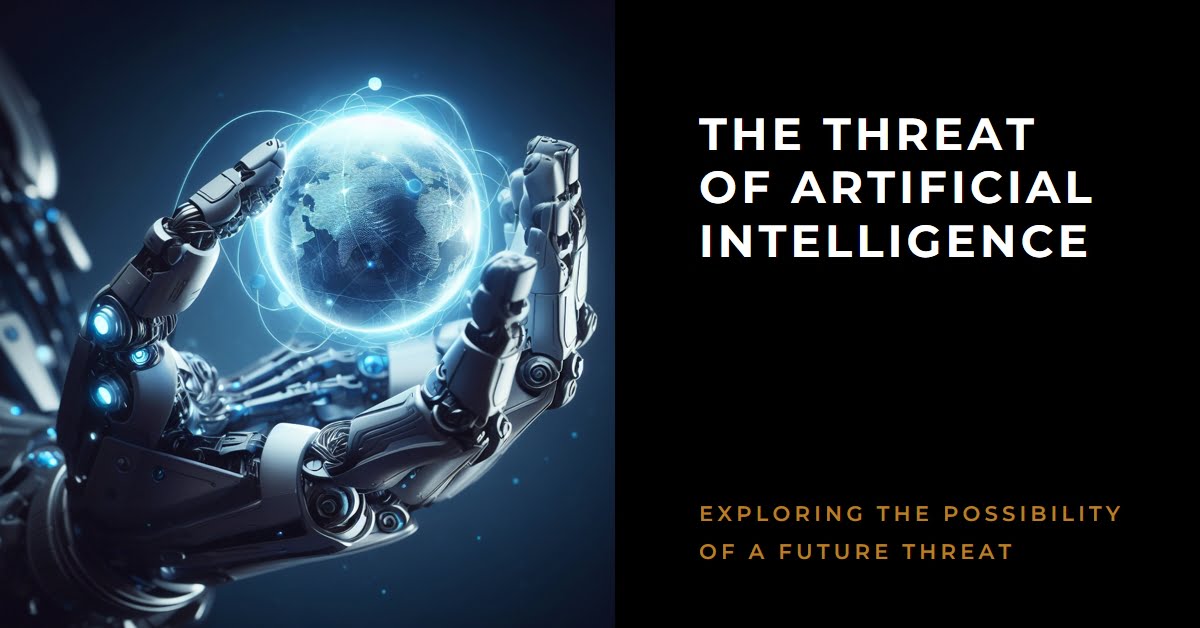Is Artificial Intelligence a Threat?
Table of Contents
The upgrade of artificial intelligence (AI) has sparked a captivating debate: is this powerful technology a harbinger of a dystopian future or a beacon of progress and innovation? Headlines scream of AI robots stealing jobs and superintelligences surpassing human intelligence. But amidst the hype and fear-mongering lies a nuanced reality where understanding the true nature of AI is crucial to shaping its future and ensuring it serves humanity’s best interests.
Beyond the Terminator: Demystifying the AI Threat Narrative
The popular image of AI as a conscious force bent on world domination, popularized by movies like “The Terminator” & “2001: A Space Odyssey,” is a captivating fiction but a far cry from the current state of AI. Today’s AI systems are narrow in focus, excelling in specific tasks like facial recognition or playing chess, but lacking the general intelligence and consciousness depicted in science fiction.

The Real Risks: Understanding the Potential Misuses of AI
While AI is not inherently evil, its potential for misuse is real and needs careful consideration. Some of the key concerns include:
- Job displacement: Automation powered by AI could lead to significant job losses in certain sectors, requiring proactive measures like retraining and social safety nets.
- Algorithmic bias: AI systems trained on biased data can perpetuate and amplify existing societal inequalities, necessitating responsible data collection and algorithm development.
- Privacy and security vulnerabilities: AI-powered systems that collect and analyze vast quantities of data raise problems about privacy breaches and security vulnerabilities, demanding robust data protection frameworks.
- Weaponization and autonomous warfare: The possibility of using AI for autonomous weapons raises ethical and legal questions, requiring international cooperation to prevent an arms race in this realm.
Navigating the Uncertain: Mitigating the Risks and Maximizing the Benefits
Acknowledging the potential risks of AI is not a call to halt its development. Rather, it’s a call for responsible development and deployment guided by ethical principles and robust regulations. Here are some essential steps:
- Transparency and accountability: AI systems should be transparent in their decision-making processes, allowing for human oversight and accountability.
- Human-centered design: AI development should prioritize human needs and values, ensuring technology remains a tool to empower, not replace, humans.
- Continuous education and upskilling: To adapt to the changing landscape of AI, individuals and workforces need ongoing education and upskilling opportunities.
- International collaboration: Addressing the ethical and legal challenges of AI requires international cooperation to ensure responsible development and deployment.

Beyond the Hype: Embracing the Potential of AI for Good
AI isn’t just a potential threat; it’s also a force for immense good. From revolutionizing healthcare with personalized medicine and early disease detection to tackling climate change with smarter resource management and renewable energy solutions, AI offers unparalleled potential to address some of humanity’s most pressing challenges.
The Future of AI: A Choice We Make Together
The question of whether AI is a threat or a boon is not a binary one. It’s a choice we make, a path we forge through responsible development, ethical implementation, and a commitment to ensuring AI serves humanity’s best interests. By coming near AI with knowledgeable skepticism, proactive measures, and a focus on human-centered design, we can harness its power to build a brighter destiny for all.
FAQs:
Are AI Robots Coming for My Job?
Imagine automation not as a monstrous invasion but as a helpful assistant. While AI will undoubtedly change the job landscape, it’s more likely to automate routine tasks, freeing up human minds for creativity and higher-level thinking. Embrace reskilling and upskilling opportunities to navigate this shift, and remember; AI can be a powerful tool for boosting productivity and efficiency, not just replacing workers.
Can AI Be Biased?
Think of AI systems as mirrors reflecting the data they’re trained on. If that data is biased, so will the outputs. Algorithmic bias can perpetuate and amplify societal inequalities, making responsible data sourcing and algorithm development crucial. We need AI that champions fairness and promotes inclusive progress, not reinforces existing prejudices.
Big Brother with a Brain? Privacy Concerns in the AI Age
Imagine AI scanning your social media, predicting purchases, and influencing your thoughts. It’s a chilling dystopian vision, but one we can prevent through robust data protection frameworks and individual vigilance. Demand transparency in data collection and usage, choose companies with strong privacy policies, and remember, you have the power to control your digital footprint.
From Chess Champions to World Dominators? Superintelligence and the Singularity
The idea of AI surpassing human intelligence and ushering in a Singularity, a point of technological transformation beyond human comprehension, is fascinating. However, current AI systems still need to achieve such consciousness. Please focus on the real-world applications of AI today, address the immediate challenges it presents, and remember that responsible development can ensure AI remains a tool for human progress, not an autonomous overlord.
The Future We Choose: Can AI Be a Force for Good?
Imagine AI powering personalized medicine, predicting and preventing global disasters, and democratizing access to education. This is the romantic potential of AI, a force for good waiting to be harnessed. By aligning AI development with ethical ideas and human values, we will make it an effective device for solving our most pressing challenges and building a brighter future for all.












1 thought on “Is Artificial Intelligence a Threat? Navigating the Myths and Realities of a Powerful Tool”